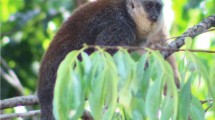Abstract
A field study of the pigtail monkey (Macaca nemestrina) was conducted in Malaysia. An initial six month survey revealed a badly disturbed, diminishing population. Intensive observation required prolonged extensive habituation efforts including a modified form of provisionization and the use of a trained captive pigtail monkey. The pigtail monkey was found to be an arboreal deep forest animal which, nonetheless, came to the ground more often than any other monkey in the forests of Malaya. Responses observed in the natural habitat could not be differentiated from those seen in captive groups; but response frequencies differed. Social patterns observed were similar to those seen in other macaques but differed notably from those seen in sympatric leaf monkeys. Travel patterns, feeding, agonistic responses, sexual behavior, play and other responses are described and discussed.
Similar content being viewed by others
References
Bernstein, I.S., 1967. Intertaxa interactions in a Malayan primate community.Folia primat., 7: 198–207.
Bertrand, Mireille, 1967. Training without reward: traditional training of pig-tailed macaques as coconut harvesters.Science, 155: 484–486.
Bobbitt, Ruth A., G.D. Jensen, &B.N. Gordan, 1964. Behavioral elements (taxonomy) for observing mother-infant-peer interaction inMacaca nemestrina.Primates, 5(3–4): 71–80.
Corner, E.J.H., 1955. Botanical collecting with monkeys.Proc. Roy. Instn., 36: 162.
Hall, K.R.L. &Barbara Mayer, 1967. Social interactions in a group of captive patas monkeys, (Erythrocebus patas).Folia primat., 5: 213–236.
Kaufmann, J.H. &L.A. Rosenblum, 1966. A behavioral taxonomy for macaques: based on laboratory observations ofMacaca nemestrina andMacaca radiata.Primates, 7(2): 205–258.
Kummer, H. & F. Kurt, 1965. A comparison of social behavior in captive and wild Hamadryas baboons. In:The Baboon in Medical Research,H. Vagtborg (ed.) Univ. Texas Press, pp. 65–80.
Malayan Film Unit—New Malayan Gazette No. 53, Item 4—Jumping Jambol, 100 ft., 16 mm., English Version, Federal Department of Information, Kuala Lumpur, Malaysia.
Van Hoof, J.A.R.A.M., 1962. Facial expressions in primates.Symp. Zool. Soc. Lond., No. 8, pp. 97–125.
Author information
Authors and Affiliations
Additional information
This research was supported by National Science Foundation grant GB 3008 and in part by NIH grant FR-00165.
About this article
Cite this article
Bernstein, I.S. A field study of the pigtail monkey (Macaca nemestrina). Primates 8, 217–228 (1967). https://doi.org/10.1007/BF01731038
Received:
Issue Date:
DOI: https://doi.org/10.1007/BF01731038




